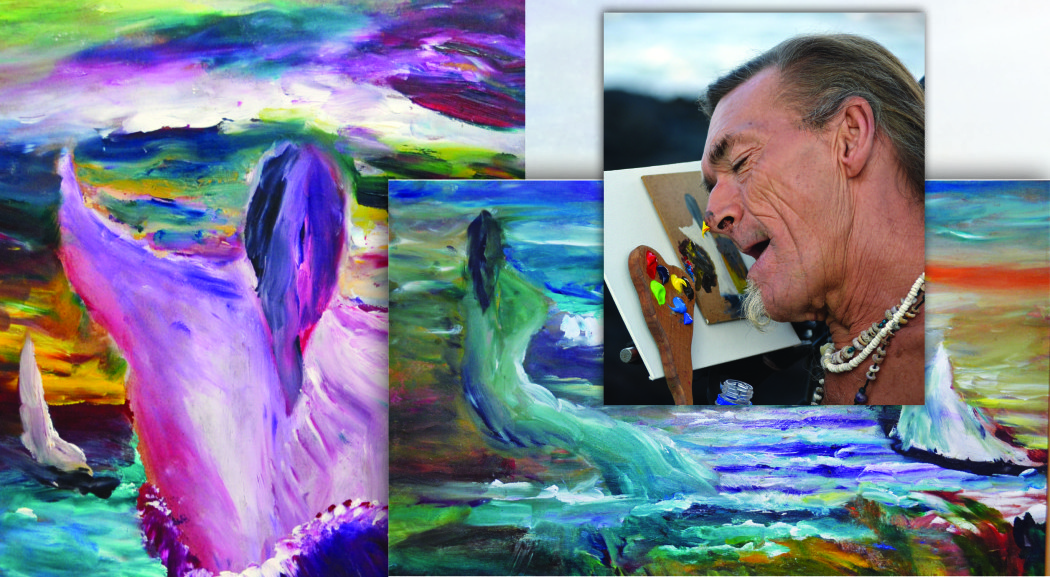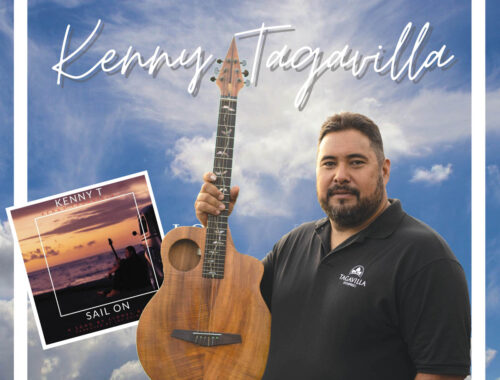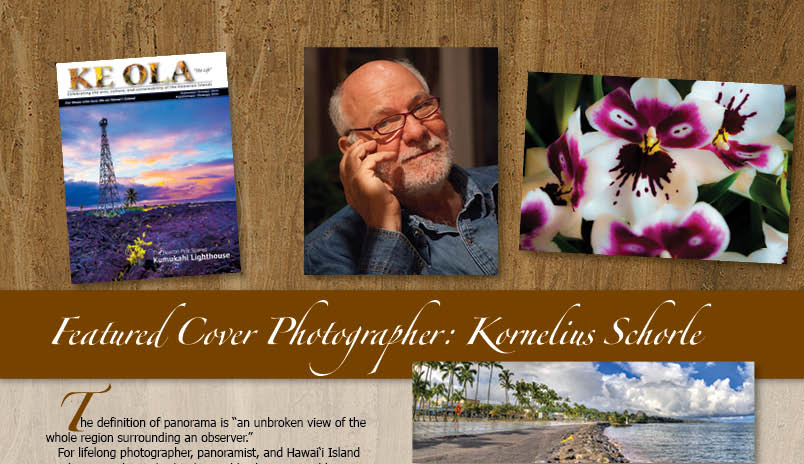
Gille Legacy: The Man Who Paints With His Nose
 By Cynthia Sweeney
By Cynthia Sweeney
Gille Legacy does not have the distractions that the rest of us do. Unable to use his body since birth, he is not confined to it and lives largely—both figuratively and literally—in his imagination. And the peace of that place comes through him and onto the canvas as a tangible connection between that world and this.
Gille Legacy is the man who paints with his nose.
How it Began
Gille, (pronounced Jheel) is the sixth of eleven children born to his French-Canadian mother and father at a small hospital in the eastern Canadian province of New Brunswick in 1952. It was a difficult birth. During labor, his mother knew something was wrong. The doctors reasoned that she was Catholic, and could go on to have more children, so the baby could be sacrificed. To get him out of the birth canal, they broke Gille’s collarbone, and his skull was crushed by the forceps. A priest was present to issue last rites.
Gille had other plans. Foreshadowing an innate determination to make his mark, he survived.
At home, his mother fed him with an eyedropper. He was kept inside the house. He never went to school or saw a doctor. He was hidden from the outside world and sheltered from his unforgiving father, who continually compared him to an animal. Back then, he says, things were different.
“Back then it happened all over. That was the intelligence of people. It wasn’t as developed as it is now,” explains Gille about his sheltered existence, adding, “If I were born in this day and age,
I would be walking.”
Although he had lost all control of movement in his body, there was no loss of intelligence. He could see and understand everything, except why he was trapped in the house and expected to do nothing at all.
When Gille was 17, he had appendicitis. After several days his mother finally took him to the hospital for treatment, after she had been afraid to leave him in their care. This was the first time he saw people other than his family, and he loved it.
Gille’s mother fed, clothed and maintained the large family on $100 a week. Still, she managed to save enough to buy Gille his first wheelchair when he was 22 years old.
Ten years later, realizing she was getting older and would not be able to take care of him forever, Gille persisted in asking his mother to send him to a new rehabilitation center in town. Finally, she relented.
Unlike other forms of cerebral palsy (an umbrella term for having no motor control from birth), Gille did not suffer a loss of oxygen, so there was no brain damage, and his condition is not degenerative. Although his speech is difficult to understand, he speaks fluent French and English and his thoughts move as fast as anyone’s. Although his skin is tan and healthy, he has no use of his twisted limbs, which he likens to the gnarled branches of an oak tree. He sports a “Dali-like” goatee, and his motorized wheelchair is decked out with an iPhone and a sign that says “Google me”.
Gille is comfortable with his body, he says, because he can go anywhere in his mind. He doesn’t know anything different. He’s never been swimming or taken a walk. And although he has bouts of depression, it’s not because of his childhood or the wheelchair. “I got my days, just like everyone else,” he says, and really seems to be the most contented guy you’ve ever met.
The Painting
Although born twisted, Gille was flexible and agile. When he was eight years old, his sister left her paint-by-number set on the floor. Curious, he scooted over to the paints and something
magic happened.
“I dipped my nose in the paint…and a bright light went on inside my head when the image of a bird appeared on the paper. I took that light and shined it throughout the years to create thousands of paintings,” he wrote in “Pigments of Thought,” his latest book.
His mother saw joy in his painting and encouraged it. By his late teens, Gille’s self-created painting style—he paints in oils and has never had the desire to use a brush—was well-developed. When he had the reach and flexibility, he painted large canvases with images of mountains and bodies of water. The mountains expressed his strength, and the water his “ever flowing rush of dreams.” Together, they expressed freedom and a lack of confinement.
“I don’t want to brag, but if you saw some of those paintings, you would be impressed,” he asserts.
Gille’s mother died in 2002. About a year later he started painting images of angels, which now predominate his work. Is he spiritual? Yes and no. Raised Catholic, he rejects church dogma. But when your nose is that close to the canvas you see your soul pouring out, he says. “Sometimes I don’t know what I’m doing, I just let it out. I live between the lines, the quiet space between the thoughts. Part of the message is for people to just be in that space.”
Some people have called his work ‘healing.’
“You can feel the spiritual energy; it draws you to the painting,” says Tess Rumley, co-owner with her husband Ron, of Rumley Art & Frame Gallery in the King Kamehameha’s Kona Beach Hotel, where his paintings are shown.
“I don’t look at him like he’s in a wheelchair. I don’t see the physical body,” she says. “He is the definition of perfect creativity. Stripped of physical capabilities, he paints from his soul. He is aware and conscious of this. People can connect right away. They can feel
the energy.”
Beyond the Art
Gille was already well established in the art and poetry world when he met his wife, Sandi, in 1998.
“I just looked at him and was fascinated,” she says. “It wasn’t really in the beginning, but now, life with him seems very normal. I’m taken aback by his strength of spirit. It has just been the most incredible adventure and awakening.”
Sandi became his hands and his voice. They have had their issues, like most couples. But they laugh, smile, hold hands, and are inseparable.
“He is in the now, in the moment. There is no 20 minutes ago, no future. He has mastered going inward and has been meditating all his life. He is at peace and doesn’t need any help in that department,” Sandi says, checking with Gille for confirmation, then adding, “He did his work and found peace and now he’s sharing it.”
“My hopes have dissipated,” Gille adds. “I don’t need to prove anything. Inspiration is still there; now I’m just sharing.”
Gille has written five books: pocket-sized volumes of ruminations, poetry and philosophy, with Sandi’s help. In “Pigments of Thought,” his latest, he gives us a glimpse into his imagination:
In one second he had the appearance of an octopus with eight legs and angelic smile and then she who is he turned into me and said to my ego something of this nature:’ Wisdom cannot and should not be seen as a trace in individuality.’ He continued by whispering, ‘It’s a sad thing to have one’s innate wisdom measured by one’s appearance.’
After moving from Canada to California, Gille and his art found an audience at the Promenade in Santa Monica, which led to a documentary of his life being filmed in 2006. They also opened
the Nose Boutique, one of many projects Gille continues to
surprise Sandi with.
“I’m just his hands, helping him to do something big,” Sandi humbly says.
In 2010, Gille and Sandi moved from California to Kona. One day he wandered into the Rumley Gallery, where he met Tess, who said meeting him and seeing his art was like an ‘awakening’ for her.
“When we create from our spirit, our soul, we don’t have to trust it, just let it flow. That’s what Gille does,” she says. “We are all creative, whatever form we choose to express. It’s within us all; we just have to pay attention to it.”
Gille’s paintings have been shown throughout Canada, the United States and France. In 2004 -2005, he was invited to show his work at the prestigious World Conference ‘Chemin du Monde.’ In 2006, he was honored with several private exhibits in Palm Springs and Rancho Mirage.
Gille would paint and be who he is regardless of whether his artwork sold or not. What matters, he says, is inspiring others. In 2005, Gille was honored as a Paul Harris Fellow by Rotary Clubs in the United States and Canada, for five years of giving inspiring, motivational speeches to school kids, telling them not to give up.
“There are no obstacles, only those you put in your own way,”
he says.
See more of Gille’s work at manwhopaints.com.
Contact writer Cynthia Sweeney at sweeneywrites@yahoo.com.


